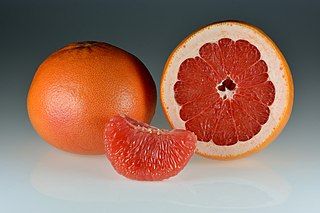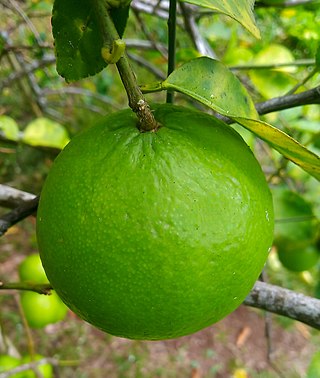
Kumquats, or cumquats in Australian English, are a group of small, angiosperm, fruit-bearing trees in the family Rutaceae. Their taxonomy is disputed. They were previously classified as forming the now-historical genus Fortunella or placed within Citrus, sensu lato. Different classifications have alternatively assigned them to anywhere from a single species, C. japonica, to numerous species representing each cultivar. Recent genomic analysis defines three pure species, Citrus hindsii, C. margarita and C. crassifolia, with C. x japonica being a hybrid of the last two.

Citrus is a genus of flowering trees and shrubs in the rue family, Rutaceae. Plants in the genus produce citrus fruits, including important crops such as oranges, lemons, grapefruits, pomelos, and limes. The genus Citrus is native to South Asia, East Asia, Southeast Asia, Melanesia, and Australia. Various citrus species have been used and domesticated by indigenous cultures in these areas since ancient times. From there its cultivation spread into Micronesia and Polynesia by the Austronesian expansion ; and to the Middle East and the Mediterranean via the incense trade route, and onwards to Europe and the Americas.

The grapefruit is a subtropical citrus tree known for its relatively large, sour to semi-sweet, somewhat bitter fruit. The interior flesh is segmented and varies in color from pale yellow to dark pink/red.

The mandarin orange, also known as mandarin or mandarine, is a small, rounded citrus tree fruit. Treated as a distinct species of orange, it is usually eaten plain or in fruit salads. Tangerines are a group of orange-coloured citrus fruit consisting of hybrids of mandarin orange with some pomelo contribution.

A lime is a citrus fruit, which is typically round, green in color, 3–6 centimetres (1.2–2.4 in) in diameter, and contains acidic juice vesicles.

The citron, historically cedrate, is a large fragrant citrus fruit with a thick rind. It is said to resemble a 'huge, rough lemon'. It is one of the original citrus fruits from which all other citrus types developed through natural hybrid speciation or artificial hybridization. Though citron cultivars take on a wide variety of physical forms, they are all closely related genetically. It is used in Asian and Mediterranean cuisine, traditional medicines, perfume, and religious rituals and offerings. Hybrids of citrons with other citrus are commercially more prominent, notably lemons and many limes.

The trifoliate orange, Citrus trifoliata, is a member of the family Rutaceae. Whether the trifoliate oranges should be considered to belong to their own genus, Poncirus, or be included in the genus Citrus is debated. The species is unusual among citrus for having deciduous, compound leaves and pubescent (downy) fruit.

Citrus bergamia, the bergamot orange, is a fragrant citrus fruit the size of an orange, with a yellow or green colour similar to a lime, depending on ripeness.

The Key lime or acid lime is a citrus hybrid native to tropical Southeast Asia. It has a spherical fruit, 2.5–5 centimetres in diameter. The Key lime is usually picked while it is still green, but it becomes yellow when ripe.

Synephrine, or, more specifically, p-synephrine, is an alkaloid, occurring naturally in some plants and animals, and also in approved drugs products as its m-substituted analog known as neo-synephrine. p-Synephrine and m-synephrine are known for their longer acting adrenergic effects compared to epinephrine and norepinephrine. This substance is present at very low concentrations in common foodstuffs such as orange juice and other orange products, both of the "sweet" and "bitter" variety. The preparations used in traditional Chinese medicine (TCM), also known as Zhi Shi (枳实), are the immature and dried whole oranges from Citrus aurantium. Extracts of the same material or purified synephrine are also marketed in the US, sometimes in combination with caffeine, as a weight-loss-promoting dietary supplement for oral consumption. While the traditional preparations have been in use for millennia as a component of TCM-formulas, synephrine itself is not an approved over the counter drug. As a pharmaceutical, m-synephrine (phenylephrine) is still used as a sympathomimetic, mostly by injection for the treatment of emergencies such as shock, and rarely orally for the treatment of bronchial problems associated with asthma and hay-fever.

Limonene is a colorless liquid aliphatic hydrocarbon classified as a cyclic monoterpene, and is the major component in the volatile oil of citrus fruit peels. The (+)-isomer, occurring more commonly in nature as the fragrance of oranges, is a flavoring agent in food manufacturing. It is also used in chemical synthesis as a precursor to carvone and as a renewables-based solvent in cleaning products. The less common (-)-isomer has a piny, turpentine-like odor, and is found in the edible parts of such plants as caraway, dill, and bergamot orange plants.

An orange is a fruit of various citrus species in the family Rutaceae ; it primarily refers to Citrus × sinensis, which is also called sweet orange, to distinguish it from the related Citrus × aurantium, referred to as bitter orange.

Citrus australis, the Dooja, round lime, Australian lime or Australian round lime, is a large shrub or small tree producing an edible fruit. It grows in forest margins in the Beenleigh area and northwards, in Queensland, Australia.
Citrus gracilis, the Humpty Doo lime or Kakadu lime, is a straggly shrub endemic to eucalypt savannah woodlands of Northern Territory, Australia.
Citrus halimii, or mountain citron, is a citrus with sour fruit. Historically placed within the polyphyletic grouping of papedas, it has since been determined to be a wild species most closely related to the kumquats, and is not related to the true citron. It was first discovered and catalogued in 1973.
The micrantha is a wild citrus from the papeda group, native to southern Philippines, particularly islands of Cebu and Bohol. Two varieties are recognized: small-flowered papeda, locally known as biasong, and small-fruited papeda or samuyao.
Citrus wintersii, the Brown River finger lime, is a shrub native to the Brown River region in Papua-New Guinea. It was previously known as Microcitrus papuana. It has, as the "finger" name suggests, a small, thin fruit, pointed at both ends. It grows near Port Moresby.

Citrus taxonomy refers to the botanical classification of the species, varieties, cultivars, and graft hybrids within the genus Citrus and related genera, found in cultivation and in the wild.

Citrus × deliciosa is a citrus hybrid mandarin orange with just under 6 % pomelo ancestry. It is related to the ponkan.

The tachibana orange is a variety of mandarin orange, a citrus fruit. They grow wild in the forests of Japan and are referred to in the poetry of the early Japanese and Ryukyu Islands kingdoms. The Tanaka System assigns them their own species, while the Swingle System places them in the same species with other mandarin oranges.
















